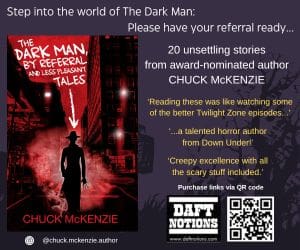WIHM: An Interview With Sara Tantlinger
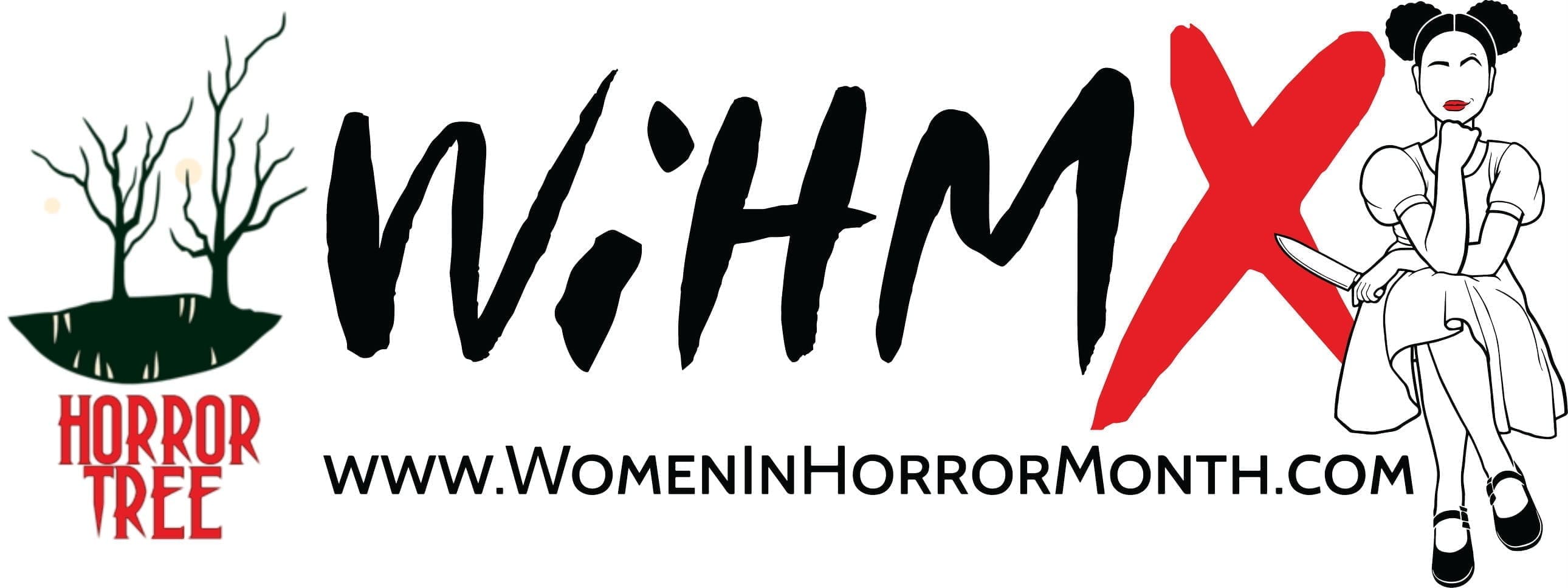
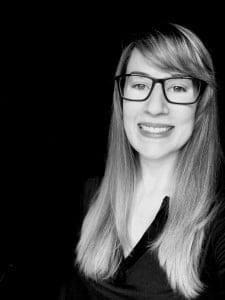 Hi Sara, and welcome to The Horror Tree – the writer and author resource! Since that’s the site’s target, we’ll be mostly talking about the process of writing and publishing here today. I’m excited to pick your brain (very gently of course)! Let’s begin.
Hi Sara, and welcome to The Horror Tree – the writer and author resource! Since that’s the site’s target, we’ll be mostly talking about the process of writing and publishing here today. I’m excited to pick your brain (very gently of course)! Let’s begin.
Erin: Tell the readership a little about your background, your published poetry titles, your work, etc. for them to create a foundation about who you are…
Sara: Thank you so much for having me!
I started dabbling with poetry in middle school after reading Edgar Allan Poe for the first time, and also as catharsis for dealing with middle school in general, especially after my dad passed away when I was twelve. My angsty, broken poetry was my outlet for the emotions I never talked about, but I never realized it was something I could hone and even publish until my undergraduate studies in college.
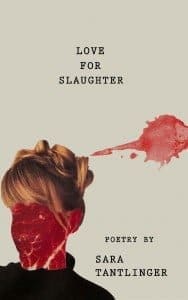 Since then, I have continued to deeply love reading and writing poetry. Cultivating that love stemmed from having great mentors, peers, and friends who helped me edit, revise, and strengthen my craft. My two poetry collections are Love For Slaughter and The Devil’s Dreamland: Poetry Inspired by H.H. Holmes. I have dozens of individual poems out there in publications too such as Abyss & Apex, The Sunlight Press, Twisted Moon Mag, and the HWA Poetry Showcase!
Since then, I have continued to deeply love reading and writing poetry. Cultivating that love stemmed from having great mentors, peers, and friends who helped me edit, revise, and strengthen my craft. My two poetry collections are Love For Slaughter and The Devil’s Dreamland: Poetry Inspired by H.H. Holmes. I have dozens of individual poems out there in publications too such as Abyss & Apex, The Sunlight Press, Twisted Moon Mag, and the HWA Poetry Showcase!
Erin: You have published your two poetry books, The Devil’s Dreamland most recently, and obviously enjoy writing poetry, but with an MFA in Writing Popular Fiction, you must dabble in writing horror short stories or novels as well. How does your mind focus over to writing longer lengths? Is it challenging? Or maybe writing poetry helps your prose?
Sara: Oh yes! I wrote a horror/dark fantasy novel for my MFA thesis and have been writing more short stories over the past two or three years. My goal this year is to actually focus on more prose, which includes editing that thesis novel again.
Poetry has been a huge help. It teaches you how to be concise, to make every word count, to create descriptive and emotive language, and to add rhythm to your words. These lessons from poetry have been instrumental in my prose. Sometimes starting with a poem when I’m feeling stuck or struggling with writer’s block can really help. I like to write poems from the viewpoints of the characters in my prose work, too – it can help me get a stronger feel for who each character is by what they might choose to include or not include in a poem.
Writing longer works is definitely challenging for me though. After my MFA program, I wasn’t sure if I’d ever attempt a novel again, but I’m currently (finally) working on a novel that I am ecstatic about. I am positive it will take me a while to write (it took me over two years to write my MFA thesis novel, after all), but using my confidence from poetry has been a huge help.
Erin: What other stories interest you to tell at length and why? What will your process be to get them onto paper? Do have any tips or tricks that help you succeed at writing goals?
Sara: With poetry, I don’t have to usually outline my ideas as much, but with prose, outlining has become an absolute must! I have story ideas jotted down all over the place, so when I finally choose to roll with one, I always try to outline and keep asking myself questions. I attended a great workshop during my MFA where the instructor encouraged us to keep asking questions of our work and to push past what our first answer would be – this exercise helped me a lot in working around clichés and tropes by questioning what else could happen rather than always going with the first idea or answer that sprang to mind.
Erin: I’m assuming as well that you like research, historical research too, by the publishing of The Devil’s Dreamland. Is that true – do you love research or is it just something has to be done for the end goal? If you like it, what fascinates you about it?
Sara: I absolutely love research. I am prone to getting lost in the research rabbit hole and never emerging. It is so, so fun, but at the same time, I can struggle with knowing when to stop the research and get on with the writing.
The Devil’s Dreamland was a trip to research because I was so desperate to try and understand this man (H.H. Holmes) from the late 1800s with shady records, who was an exquisite liar, and who was just kind of beyond understanding. I had a blast trying though and ended up being proud of the pieces I did connect, the research I did discover – it all came together to create a unique poetry book that can also appeal to true crime and horror fans in general (I hope!).
Erin: What tips do you have for other writers in regard to research? Predominately horror writers are often quoted as not doing or not needing to do a lot of research for their content (as other genres) but do you think that this is changing? Do you find more people delving into the past for story ideas?
Sara: I always research something for my work, even if it is a small piece of information, so I have no idea what these writers are doing, but I do think you should always fact check yourself while writing. Sometimes research is using Google or going to the library, but sometimes it is having a conversation with someone of a certain expertise or background that can help add creativity, realism, and truth to your work. I can’t imagine not embracing research on some level.
Right now, I am aiming to write a historical horror novel that takes place in 1800s Madagascar, so, needless to say research is necessary to add accuracy for the story I want to create. However, sometimes you do need to let certain things go (as I am constantly learning with historical fiction/horror) because if I’m spending five hours researching what glass and windows and gowns might have looked like during this time period and not doing any writing, then that’s where it becomes an issue because I’ll never get the book done! Beta readers experienced in history or the culture you are researching are going to be amazingly helpful.
I do think there is a solid interest in true crime and historical horror right now. Perhaps there is nothing more terrifying than what we as human beings have done to each other in the past; and maybe, given the chaos of current times, reaching into past terrors is our strange way of trying to cope with or warn others about history repeating itself, and about what we are still doing to each other now.
Erin: Being a fellow poet myself, I know that often we are seen to just be writing poetry of our “feelings,” but that’s not always the case. I know myself I do a lot of research for some of my poems if they are based on a myth, legend, historical place, etc. I love to look at images and read about it to get a better “sense.” Obviously, research of serial killer H.H. Holmes for your publication The Devil’s Dreamland was necessary for you. What types of things did you research, read, look at, etc. before you started or while writing your collection?
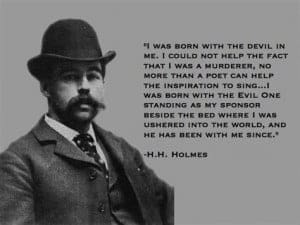 Sara: I love to look at images, too! It really helps with poetry since you are trying to create something sensational with just a few words. For The Devil’s Dreamland, I did research newspaper headlines, profile sketches, and supposed blueprints of Holmes’ Murder Castle, all of which were eerie and inspired ideas. I read The Devil in the White City, which was fun, but definitely embellished on Larson’s interpretation of Holmes more than I was looking for, so I turned to Adam Selzer’s amazing and extensive research on what was thought to be true and what remains unknown. I really recommend his research to anyone who wants to understand the minute details of Holmes’ case. I also read horror legend Robert Bloch’s American Gothic, which is an inventive fictionalized version of Holmes’ story with Holmes being renamed “G. Gordon Gregg” – I loved it!
Sara: I love to look at images, too! It really helps with poetry since you are trying to create something sensational with just a few words. For The Devil’s Dreamland, I did research newspaper headlines, profile sketches, and supposed blueprints of Holmes’ Murder Castle, all of which were eerie and inspired ideas. I read The Devil in the White City, which was fun, but definitely embellished on Larson’s interpretation of Holmes more than I was looking for, so I turned to Adam Selzer’s amazing and extensive research on what was thought to be true and what remains unknown. I really recommend his research to anyone who wants to understand the minute details of Holmes’ case. I also read horror legend Robert Bloch’s American Gothic, which is an inventive fictionalized version of Holmes’ story with Holmes being renamed “G. Gordon Gregg” – I loved it!
I did watch a few documentaries and listened to a podcast or two about Holmes, as well. And, of course, I had to read Holmes’ prison memoir and “confession,” both of which he wrote in jail. I read both of them numerous times, and then proceeded to research analyses of the works to help decipher what he was lying about in his writing, which was a lot! He was a con-man through and through.
Erin: How did writing The Devil’s Dreamland differ from Love for Slaughter? How are they different but how are they alike?
Sara: Love For Slaughter was much more emotional, aiming to focus on the idea of Folie à Deux (madness shared by two), and how love and lust can drive one to the brink of obsession and insanity. It is a bloody, sensual nightmare with visceral depictions of the ways love can consume us. Each poem is meant to have its own story of brutal lovers, but all the pieces fit into the theme.
The Devil’s Dreamland, on the other hand, has a more narrative arc and reads like a story, which I think helps it appeal to people who may be wary of poetry. It is cold, calculating, and dark – much how I interpreted H.H. Holmes to be. I think both collections have some similarities with themes of madness, but I wanted my second collection to be as different from the first as possible. It was important to me to show others and myself that I am capable of writing two very different collections but putting equal time and consideration into both.
Erin: You also teach writing, are a writing coach, and edit poetry – how do you feel about poetry structure today? Are you hard and fast to rules or more of a creative thinker? What is some advice you give to first time writers who want to tackle dark or horror poetry?
Sara: I encourage anyone to write poetry the way they want to – following structure and rules can be a fantastic exercise and challenge, but I love seeing what writers do with free form, too. However, even if you aren’t writing a villanelle or a sonnet, you should still thoughtfully choose your words, read the work aloud to see what the rhythm and flow is like, and evoke the senses as much as possible. It is also so important to read and study the forms and structures of classic poetry as well as the more contemporary free verse poems I see (and write) a lot. Understanding the history of poetry and its development over time can really give you a strong foundation.
To anyone thinking of tackling dark/horror poetry, my main advice is to read as much as possible, but try to discover your own voice along the way – no one is really looking for a mimic of Poe because no one is ever going to write like Poe! Read, write and write some more, and then read and read some more. Talk to poets you love and round up some honest beta readers. Also, one thing that drives me crazy, edit and revise your poetry! Just because it is a short work, does not mean it escapes the need to be edited or heavily revised.
Erin: Then, what is some advice you might give to first time writers of prose?
Sara: Outline! I was a “panster” for the longest time, but becoming a plotter and outlining more has easily helped me create stronger stories. My advice is pretty similar to the above advice with poetry – read good work and know what is happening in your genre. Find a short story you love and dissect it. What does the writer do that captivates you? Analyze the structure, the dialogue, the setting, everything. I also recommend investing in good craft books; I come back to the ones I used in graduate school time and time again.
Erin: How do you think horror writing is evolving?
Sara: One of my favorite aspects of horror writing is that it so often reflects societal and cultural times back at us, like a really disturbing mirror. Women and minorities are angry, and we aren’t going away. I think new work will continue to evolve and stem from these constant oppressions, violence, and dismissal of voices. Literacy is power, and giving writers an outlet like horror to express and address these critical issues is going to have a huge impact on the genre – an impact I look forward to.
Erin: Do you feel like horror is becoming more inclusive to minorities and accepting of diversity? How can writers do a better in the genre in terms of this with their interactions, promotions, acquiring, or even writing characters?
Sara: I think we’re getting there but have a long way to go. I still see too many anthologies using the same writers over and over again, which often does not include much diversity at all. Mostly, I hope to see those in positions of power use their privilege to help promote and seek out diversity. I also think writers can do better by taking the time to interview or talk with people from diverse backgrounds, attend workshops on diversity to learn more about writing characters outside your own race/sex/gender/etc…, and by reading more work from diverse writers.
Erin: I think women in horror are doing some amazing things at the moment. What do you think women writers in horror bring to the table for readers? How can men support them?
Sara: Women have been dealing with inescapable horror since our existence – I think that makes us positively terrifying to behold. When we have that chance to bring those experiences to the table, and to cultivate the darkest pieces of our lives and minds into horror writing, it can create truly powerful and moving work. Womanhood is a complex, strange, and constantly changing thing – yet sharing such moments and twisting them into the characters we create can really affect readers in important ways
Men can support women in horror in so many ways – something small like helping to promote, share, or direct readers to a woman with a great work is always appreciated. There are many male editors and publishers out there who can continue (or start) to reinforce the importance of diversity and promote open calls to online groups of women writers, too. In horror, we all benefit from each other’s success and promotion of the genre.
Erin: You’re in the middle of curating an anthology for StrangeHouse that is all female. Why did you decide to make this a women-only anthology and how did that go in terms of submissions? Is there more female talent out there than the genre is realizing?
Sara: I am so excited for this anthology! Nick Day, who co-owns StrangeHouse, and I were having a conversation one day about some guys on a social media forum who were crying about diversity and women and how difficult it was to get diverse writers into an anthology (eye roll). The whole thing was just gross. Nick had a fabulous idea for StrangeHouse to publish an all-female anthology in response to this nonsense, and he asked me if I’d be interested in editing the book and kind of being in charge of it, so I of course said yes! I love editing, and being able to do something to specifically help bring attention to women in horror makes me so happy and proud of these writers.
Erin: How is the process going overall doing this for the first time? What challenges do you have and what has thrilled you? What will it be called and when is the release?
Sara: The anthology is titled Not All Monsters and should be released in 2020. I have edited for much tinier slush piles before, but I did not expect nearly 300 submissions for this anthology. However, I am glad women from all around the globe have been sending in work for me to read.
Narrowing down what stories to include is beyond difficult. The ladies who submitted really brought their A-game to this open call, and it is going to be heartbreaking to send rejections out, but I am positive those stories will find homes, too. So while passing on stories and deciding what fits the theme best has been a challenge, it has also been amazing to discover new names and keep them on my radar to see what these women do in the future – I have a feeling they will continue to create amazing work.
Erin: What is some advice you can give to writers in terms of making their work publishable AND presenting it as publishable? What do editors want to see and maybe not want to see? Tips?
Sara: Follow the guidelines! For the love of all that is holy or unholy, follow the guidelines, and follow proper manuscript format. Please.
Otherwise, proofread, edit, and revise your work before sending (beta readers are invaluable sources, too). When there are numerous typos on the first page, it is really off-putting to keep reading. It definitely helps to get the story done, take a few days away from it, print it out, and then read it again on paper. I always catch my own mistakes more when I take some time away from a work and print it out to read on a different medium than the computer screen.
And, this is a total pet peeve, but when there is no greeting, no subject, and just nothing in the email but an attachment, it makes me a grumpy editor, too. Put in the subject, say “Dear editor,” and at least sign your name on the email – it looks more courteous and professional rather than just shoving a manuscript at someone and running away.
Erin: And finally, one fun question. What is your favorite writing spot?
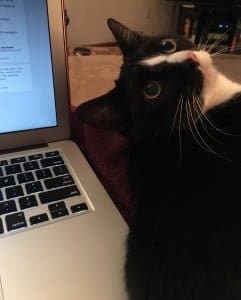 Sara: Anywhere that has snacks and coffee! (I love Panera). Usually I just write downstairs in the giant squishy chair and am often joined by my big, nosey cat, Zorro 🙂
Sara: Anywhere that has snacks and coffee! (I love Panera). Usually I just write downstairs in the giant squishy chair and am often joined by my big, nosey cat, Zorro 🙂
Erin: Thank you so much for answering all my grilling questions, Sara! I wish you all the best in 2019!
Sara Tantlinger Biography –
Sara Tantlinger resides outside of Pittsburgh on a hill in the woods. Her dark poetry collections Love for Slaughter and The Devil’s Dreamland: Poetry Inspired by H.H. Holmes are published with StrangeHouse books. She is a poetry editor for the Oddville Press, a graduate of Seton Hill’s MFA program, a member of the SFPA, and an active member of the HWA. She embraces all things strange and can be found lurking in graveyards or on Twitter @SaraJane524 and at saratantlinger.com
Sara’s poetry, flash fiction, and short stories can be found in several magazines and anthologies, including the HWA Poetry Showcase Vol. II and V, the Horror Zine, Unnerving, Abyss & Apex, the 2018 Rhysling Anthology, 100 Word Horrors, and the Sunlight Press. Currently, Sara is editing Not All Monsters, an anthology that will be comprised entirely of women who write speculative fiction. The anthology is set for a 2020 release with StrangeHouse Books.
Find out more about Sara at her website!
 Sarah’s Latest Collection –
Sarah’s Latest Collection –
The Devil’s Dreamland
H.H. Holmes committed ghastly crimes in the late 19th century. Many of which occurred within his legendary “Murder Castle” in Chicago, Illinois. He is often considered America’s first serial killer.
In her second book of poetry from Strangehouse Books, Sara Tantlinger (Love For Slaughter) takes inspiration from accounts and tales which spawned from the misdeeds of one Herman Webster Mudgett, better known as Dr. Henry Howard Holmes. Fact and speculation intertwine herein, just as they did during the man’s own lifetime.
There’s plenty of room in the cellar for everyone in The Devil’s Dreamland.
“…chilling poetry…” —Linda D. Addison, award-winning author of “How to Recognize a Demon Has Become Your Friend” and HWA Lifetime Achievement Award winner
“…morbidly creative and profound crime documentary…one of the best works of horror poetry I’ve read in years.” —Michael Arnzen, Bram Stoker Award-winning author of Grave Markings and Play Dead
“…fascinating and absolutely riveting…powerful and vivid prose…will stay with you long after you’ve closed the book.”—Christina Sng, Bram Stoker Award-winning author of A Collection of Nightmares
- About the Author
- Latest Posts
Erin Sweet Al-Mehairi has Bachelor of Arts degrees in English, Journalism, and History. She is an author and has over twenty years of experience in her field which includes being a professional writer, a journalist, an editor, and a PR Professional/publicist among many other things.
Breathe. Breathe. (Unnerving in 2017) is her Amazon best-selling (paid) debut collection and a mix of dark poetry and short stories. She has stories and poetry featured in several other anthologies and magazines and was the co-curating editor of the gothic anthology Haunted are These Houses.
She is an editor at Sinister Grin Press, assists with publicity at Raw Dog Screaming Press, and owns Addison’s Compass Public Relations and Hook of a Book Media, the latter from which she’s busy freelance editing, coaching writers, and doing book publicity and more.
She continues to make progress on her novels and write multiple stories and poems from the forests of rural Ohio while juggling activities and meltdowns of her three children and a cat. You can e-mail her at hookofabook (at) hotmail (dot) com and find her easily at www.hookofabook.wordpress.com. You’ll also find her on her Amazon page, GoodReads, Facebook, Twitter, and Instagram.




